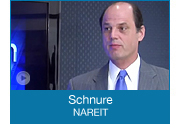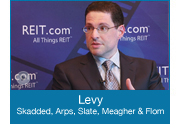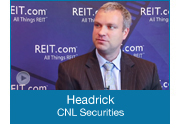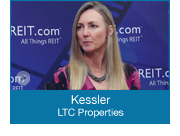|
April 16, 2012
Message from the President
 Today, REITs reside in more than 20 developed and developing countries around the world. Viewing the world’s major economies through the prism of the Group of Twenty Finance Ministers and Central Bank Governors (G-20), 12 of the 19 member countries now embrace REITs through local laws, with several more, including China and India, expected to do so in coming years. Today, REITs reside in more than 20 developed and developing countries around the world. Viewing the world’s major economies through the prism of the Group of Twenty Finance Ministers and Central Bank Governors (G-20), 12 of the 19 member countries now embrace REITs through local laws, with several more, including China and India, expected to do so in coming years.
REITs worldwide have a large and growing footprint. The industry-leading global benchmark for listed REITs and real estate investment is the FTSE EPRA/NAREIT Global Real Estate Index, which is produced and managed by FTSE Group in partnership with NAREIT and the European Public Real Estate Association (EPRA). The index includes 391 listed REITs and real estate companies in 38 developed and emerging countries with a total equity market capitalization of $940 billion. Of these totals, REITs account for 67 percent of the equity market capitalization of the index, while non-REIT real estate companies account for the remaining 33 percent.
Given the global nature of REIT and listed real estate investment today, NAREIT is increasingly active with a range of issues under consideration by policy makers both inside and outside the United States.
As the story in this issue of NewsBrief relates, NAREIT last week participated in the Brussels Summit of the European Public Real Estate Association’s Reporting and Accounting Committee, at which NAREIT staff members provided an update on the U.S. Financial Accounting Standards Board’s (FASB) project to develop a standard for reporting investment property, among other accounting issues with international ramifications.
In addition, NAREIT is now reviewing and will likely comment on the consultation currently underway by the United Kingdom’s Treasury on how the U.K. REIT rules could be improved to help support the housing sector and to permit REITs to invest in other REITs.
Finally, NAREIT continues to weigh in on the European Union’s development of rules applying to alternative investment fund managers. We do so to ensure that there is a clear line between what is considered a fund for purposes of the EU directive and what is deemed a regular operating real estate business, like most U.S. REITs, which should be outside the scope of the directive.
As we undertake these types of policy initiatives, we work closely with our partners in the Real Estate Equity Securitization Alliance as well as other local representative organizations.

Steven A. Wechsler
President and CEO
NAREIT Meets With Treasury; IRS Issues 337(d) Proposed Regulations
 NAREIT met with Treasury Department officials last week to discuss a number of regulatory and legislative issues facing the REIT industry. NAREIT met with Treasury Department officials last week to discuss a number of regulatory and legislative issues facing the REIT industry.
Executive Vice President & General Counsel Tony Edwards and Senior Tax Counsel Dara Bernstein represented NAREIT at the April 11 meeting. Among the items discussed was the U.S. REIT Act, which is expected to be introduced in Congress next month.
The participants also covered items on the IRS/Treasury Priority List. They included money market funds as a “good” REIT investment, further guidance on a REIT’s acquisition of distressed debt instruments and a possible new issue for the coming year’s Priority List.
One issue that was part of the dialogue was the built-in gain (BIG) rules for REITs. In 2008, the ABA Tax Section submitted a comment letter asking the IRS to amend the final section 337(d) regulations to clarify that BIGs triggered by like kind exchanges or that are attributable to a tax-exempt entity’s contribution of property to a REIT should not be recognized either upon the contribution or if the REIT sells the property within the 10-year holding period for BIG property. Since then, NAREIT has requested that Treasury and the IRS act on the ABA’s recommendation.
On April 13, the IRS filed with the Federal Register proposed regulations that appear to favorably respond to the ABA Tax Section’s request. NAREIT is organizing a task force to more thoroughly analyze the proposed regulations and to draft a comment letter.
(Contact: Dara Bernstein at dbernstein@nareit.com)
REIT.com Video: Calvin Schnure, NAREIT
 March unemployment numbers were disappointing, but that doesn't mean the economic recovery is on the skids, said NAREIT Vice President of Research and Industry Information Calvin Schnure. "That's just indicative of how the economic recovery has been going," he said. "It has been two steps forward, one step sideways. This was not really a step back. It's just a step sideways saying the economy is taking longer to pick up speed." March unemployment numbers were disappointing, but that doesn't mean the economic recovery is on the skids, said NAREIT Vice President of Research and Industry Information Calvin Schnure. "That's just indicative of how the economic recovery has been going," he said. "It has been two steps forward, one step sideways. This was not really a step back. It's just a step sideways saying the economy is taking longer to pick up speed."
One trend to watch, according to Schnure, is the deleveraging of households. “Households are not nearly as fragile as they were two or three years ago,” he said. At present, the household savings rate is in line with balance sheets, he said, which is a sign that people feel more stable about their fiscal situation.
“Household balance sheets have actually progressed pretty far in their balance sheet restructuring,” Schnure said. “With deleveraging and lower interest rates, the financial obligations ratio is the lowest it has been in 20 years. This is something that’s really helping the consumer sector, so as the economic recovery continues, the consumers are not really robust, they’re not leading any vigorous recovery, but they are well-positioned to increase their spending.”
The potential increase in consumer spending bodes well for the retail sector of the commercial real estate industry, Schnure said.
(Contact: Calvin Schnure at cschnure@nareit.com)
NAREIT Participates in Summit of EPRA Reporting and Accounting Committee
 On April 11-12, NAREIT representatives participated in the Brussels Summit that focused on the activities of the European Public Real Estate Association (EPRA) Reporting and Accounting Committee. On April 11-12, NAREIT representatives participated in the Brussels Summit that focused on the activities of the European Public Real Estate Association (EPRA) Reporting and Accounting Committee.
Representing NAREIT at the Summit were George Yungmann, senior vice president of financial standards, and Christopher Drula, senior director of financial standards. Approximately 35 financial executives of real estate companies located throughout Europe attended the meeting. NAREIT presented the current status of the Financial Accounting Standards Board (FASB) Investment Property Entities exposure draft, the FASB and International Accounting Standards Board (IASB) exposure drafts on Investment Companies/Entities, and recent developments regarding NAREIT funds from operations (FFO) reporting. Other topics discussed at the Summit included a Regulatory Update, Solvency II, a JP Morgan survey of valuations of investment property, and current issues with respect to raising equity capital in Europe.
(Contact: Christopher Drula at cdrula@nareit.com)
NAREIT Comments on Reporting Rules for Unlisted Direct Participation Programs and REITs
 On April 11, NAREIT wrote to FINRA regarding Regulatory Notice 12-14. On April 11, NAREIT wrote to FINRA regarding Regulatory Notice 12-14.
In Notice 12-14, FINRA requested comment on proposed changes to NASD Rule 2340 (Customer Account Statements) with respect to how per share estimated values of unlisted Direct Participation Programs and unlisted REITs are reported on customer account statements.
In its comment letter, NAREIT supported most of the rule changes proposed by FINRA and requested additional clarification on a host of provisions, including transition rules and determining per share estimated value.
(Contact: Victoria Rostow at vrostow@nareit.com)
REIT.com Videos: REITWise 2012
REIT.com had the opportunity to interview a number of leading practitioners and investors at REITWise 2012®: NAREIT's Law, Accounting & Finance Conference in Hollywood, Fla., to hear their thoughts on some of the most important issues currently facing REITs and the commercial real estate industry. Be sure to visit REIT.com in the weeks to come for more insights from REITWise 2012.
 An abundance of opportunities exist for companies in non-traditional REIT businesses to convert to REITs, according to David Levy, tax partner with the law firm Skadden, Arps, Slate, Meagher & Flom. Levy discussed what he characterized as the “evolving REIT sector.” This consists of a diverse group of companies that have a variety of business models. They specialize in areas ranging from cell towers to prisons to data centers. Essentially, “any type of business that requires the business to either own a lot of real estate in order to function or lease a lot of real estate in order to function” is “REIT-able” in Levy’s opinion. As such, Levy said he foresees a wave of specialty REITs coming to the market in the near future. An abundance of opportunities exist for companies in non-traditional REIT businesses to convert to REITs, according to David Levy, tax partner with the law firm Skadden, Arps, Slate, Meagher & Flom. Levy discussed what he characterized as the “evolving REIT sector.” This consists of a diverse group of companies that have a variety of business models. They specialize in areas ranging from cell towers to prisons to data centers. Essentially, “any type of business that requires the business to either own a lot of real estate in order to function or lease a lot of real estate in order to function” is “REIT-able” in Levy’s opinion. As such, Levy said he foresees a wave of specialty REITs coming to the market in the near future.
 Private real estate returns are at a more sustainable level today than they were in early 2011, according to Jeffrey Fisher, senior global consultant with Real Capital Analytics & Argus Software and co-president of the Homer Hoyt Institute. “I think what we’re seeing is a continuation of the trends we saw in the fourth quarter of 2011 with returns moderating,” Fisher said. Private real estate returns in 2011 were around 12 percent. Fisher said returns earlier in the year were at the 16 percent level on an unlevered basis, but he never considered them sustainable. Private real estate returns are at a more sustainable level today than they were in early 2011, according to Jeffrey Fisher, senior global consultant with Real Capital Analytics & Argus Software and co-president of the Homer Hoyt Institute. “I think what we’re seeing is a continuation of the trends we saw in the fourth quarter of 2011 with returns moderating,” Fisher said. Private real estate returns in 2011 were around 12 percent. Fisher said returns earlier in the year were at the 16 percent level on an unlevered basis, but he never considered them sustainable.
 The public non-listed REIT market is attracting attention from regulators over their pricing and valuation, according to Nathan Headrick, chief compliance officer and corporate counsel for CNL Securities. “You have to say it’s good to be living in interesting times,” he quipped. On the valuation side of their regulation, Headrick said public, non-listed REITs are addressing new requirements handed down by the Securities and Exchange Commission (SEC). “The SEC has given us a number of guidelines on how we can explain the prices for our shares as our funds mature and start to issue estimated per-share valuations,” he said. The public non-listed REIT market is attracting attention from regulators over their pricing and valuation, according to Nathan Headrick, chief compliance officer and corporate counsel for CNL Securities. “You have to say it’s good to be living in interesting times,” he quipped. On the valuation side of their regulation, Headrick said public, non-listed REITs are addressing new requirements handed down by the Securities and Exchange Commission (SEC). “The SEC has given us a number of guidelines on how we can explain the prices for our shares as our funds mature and start to issue estimated per-share valuations,” he said.
 Health care REITs have been able to benefit from the REIT Investment Diversification and Empowerment Act (RIDEA) , according to Pam Kessler, executive vice president and chief financial officer with LTC Properties Inc. (NYSE: LTC). She said RIDEA has allowed health care REITs to “participate in the upside of their properties,” as opposed to being limited to the triple net lease structure. The downside of the law, according to Kessler: It still deters health care REITs from operating certain health care facilities, which means paying a third-party management fee in some cases. Kessler added that other REITs, such as those in the apartment and office sectors, are free to operate their properties as they see fit. Health care REITs have been able to benefit from the REIT Investment Diversification and Empowerment Act (RIDEA) , according to Pam Kessler, executive vice president and chief financial officer with LTC Properties Inc. (NYSE: LTC). She said RIDEA has allowed health care REITs to “participate in the upside of their properties,” as opposed to being limited to the triple net lease structure. The downside of the law, according to Kessler: It still deters health care REITs from operating certain health care facilities, which means paying a third-party management fee in some cases. Kessler added that other REITs, such as those in the apartment and office sectors, are free to operate their properties as they see fit.
(Contact: Matt Bechard at mbechard@nareit.com)
NAREIT Welcomes Three New Members
NAREIT welcomed Griffin-American Healthcare REIT II, Griffin Capital Net Lease REIT and Rouse Properties as its newest Corporate Members.
 Griffin-American Healthcare REIT II is a public, non-listed, externally managed equity REIT that invests in a diversified portfolio of real estate properties, focusing primarily on medical office buildings and health care-related facilities. Based in Newport Beach, CA, Griffin-American is the former Grubb & Ellis Healthcare REIT II, and is now externally managed by American Healthcare Investors, LLC and Griffin Capital Corporation. Jeffrey Hanson is its chairman and CEO, and Danny Prosky is the company’s president and COO. Griffin-American Healthcare REIT II is a public, non-listed, externally managed equity REIT that invests in a diversified portfolio of real estate properties, focusing primarily on medical office buildings and health care-related facilities. Based in Newport Beach, CA, Griffin-American is the former Grubb & Ellis Healthcare REIT II, and is now externally managed by American Healthcare Investors, LLC and Griffin Capital Corporation. Jeffrey Hanson is its chairman and CEO, and Danny Prosky is the company’s president and COO.
 Griffin Capital Net Lease REIT is a public, non-listed, externally managed equity REIT that focuses on acquiring business-essential, single-tenant office and industrial properties net leased to creditworthy corporate tenants which are diversified by corporate credit, geography, product type and lease length. Based in El Segundo, CA, Griffin Capital is a sister REIT to Griffin-American in that it shares Griffin Capital Corporation as an external manager. Kevin Shields is the company’s president. Griffin Capital Net Lease REIT is a public, non-listed, externally managed equity REIT that focuses on acquiring business-essential, single-tenant office and industrial properties net leased to creditworthy corporate tenants which are diversified by corporate credit, geography, product type and lease length. Based in El Segundo, CA, Griffin Capital is a sister REIT to Griffin-American in that it shares Griffin Capital Corporation as an external manager. Kevin Shields is the company’s president.
 Rouse Properties (NYSE: RSE) is a leading owner, manager and innovator of Class B enclosed regional malls in primary, secondary and tertiary markets throughout the U.S. Based in New York City, Rouse recently was spun off from General Growth Properties (NYSE: GGP). Andrew Silberfein is Rouse’s president and CEO. Rouse Properties (NYSE: RSE) is a leading owner, manager and innovator of Class B enclosed regional malls in primary, secondary and tertiary markets throughout the U.S. Based in New York City, Rouse recently was spun off from General Growth Properties (NYSE: GGP). Andrew Silberfein is Rouse’s president and CEO.
(Contact: Bonnie Gottlieb at bgottlieb@nareit.com)
NAREIT's Leader in the Light Working Forum Only One Week Away
 NAREIT corporate members with responsibility for activities related to sustainability are encouraged to attend NAREIT's second annual Leader in the Light Working Forum. The event will be held April 23 - 24 in the Dallas office of RealFoundations, a management consulting firm that is actively assisting NAREIT to enhance the Leader in the Light program's framework. NAREIT corporate members with responsibility for activities related to sustainability are encouraged to attend NAREIT's second annual Leader in the Light Working Forum. The event will be held April 23 - 24 in the Dallas office of RealFoundations, a management consulting firm that is actively assisting NAREIT to enhance the Leader in the Light program's framework.
Since 2005, NAREIT's Leader in the Light award program has honored NAREIT member companies that have demonstrated superior and sustained energy use practices and sustainability initiatives. In recent years, NAREIT also has been involved in an advisory capacity with the Global Real Estate Sustainability Benchmark (GRESB) survey, a science-based benchmark to measure the environmental performance of property portfolios based on an annual survey produced by the GRESB Foundation.
With the GRESB initiative backed by more than 30 of the world's largest institutional investors, representing over $1.7 trillion in assets under management (including APG Asset Management, Aviva Investors, PGGM Investments and others), together with leading academics and industry bodies, NAREIT is evaluating taking a more active role in helping to increase the visibility of the upcoming 2012 GRESB survey.
An integral element of the upcoming Leader in the Light Working Forum will be for NAREIT corporate members to evaluate whether NAREIT's Leader in the Light award program should be more integrated and aligned with the GRESB platform; and, if so, whether a NAREIT "Sustainability Committee" would be helpful to the assessment of future activities.
Visit the Leader in the Light home page on REIT.com to learn more about the event and register online.
(Contact: Sheldon Groner at sgroner@nareit.com)
Case Discusses REIT-Stock Correlations in Journal of Real Estate Finance and Economics
 Brad Case published an academic paper on REIT-stock correlations in the Journal of Real Estate Finance and Economics. The paper, “Dynamic Correlations Among Asset Classes: REIT and Stock Returns,” co-authored with Yawei Yang and Yildiray Yildirim of Syracuse University, used an empirical technique called Dynamic Conditional Correlation with Generalized Autoregressive Conditional Heteroskedasticity (DCC-GARCH) to investigate how REIT-stock correlations have changed since 1972. The analysis suggested that using DCC-GARCH rather than a rolling model to estimate asset correlations in crafting a portfolio would have improved portfolio returns by more than 20 basis points per year. NAREIT staff has been updating the DCC-GARCH analysis monthly since 2008, and have made it a regular part of outreach meetings with the institutional investment community. Brad Case published an academic paper on REIT-stock correlations in the Journal of Real Estate Finance and Economics. The paper, “Dynamic Correlations Among Asset Classes: REIT and Stock Returns,” co-authored with Yawei Yang and Yildiray Yildirim of Syracuse University, used an empirical technique called Dynamic Conditional Correlation with Generalized Autoregressive Conditional Heteroskedasticity (DCC-GARCH) to investigate how REIT-stock correlations have changed since 1972. The analysis suggested that using DCC-GARCH rather than a rolling model to estimate asset correlations in crafting a portfolio would have improved portfolio returns by more than 20 basis points per year. NAREIT staff has been updating the DCC-GARCH analysis monthly since 2008, and have made it a regular part of outreach meetings with the institutional investment community.
(Contact: Brad Case at bcase@nareit.com)
Real Estate Luminaries Event to Feature Roth, Kirby
 The next installment of the Real Estate Luminaries Series is set for April 19, 2012. The next installment of the Real Estate Luminaries Series is set for April 19, 2012.
Identifying investment opportunities during this period of economic recovery will be the focus of the latest event hosted by NAREIT and Georgetown University's McDonough School of Business. The April 19 event will be held from 4 p.m. to 7:30 p.m. at Georgetown's Lohrfink Auditorium.
This event will feature a discussion between Vornado Realty Trust (NYSE: VNO) Chairman Steven Roth, Green Street Advisors Chairman and Director of Research Mike Kirby and NAREIT President and CEO Steven Wechsler. There will also be several guest speakers, including Tobin Cobb, co-CEO, LNR Property LLC; Stephen Plavin, CEO, Capital Trust; and Robert O'Brien, partner, vice chairman and U.S. real estate services leader, Deloitte. Immediately following the speaking portion of the event, NAREIT will host a reception for all attendees.
The event is complimentary, but space is limited, so RSVP’s are required. Click HERE to RSVP.
(Contact: Jeff Henriksen at jhenriksen@nareit.com)
|

 Today, REITs reside in more than 20 developed and developing countries around the world. Viewing the world’s major economies through the prism of the Group of Twenty Finance Ministers and Central Bank Governors (G-20), 12 of the 19 member countries now embrace REITs through local laws, with several more, including China and India, expected to do so in coming years.
Today, REITs reside in more than 20 developed and developing countries around the world. Viewing the world’s major economies through the prism of the Group of Twenty Finance Ministers and Central Bank Governors (G-20), 12 of the 19 member countries now embrace REITs through local laws, with several more, including China and India, expected to do so in coming years.
 NAREIT met with Treasury Department officials last week to discuss a number of regulatory and legislative issues facing the REIT industry.
NAREIT met with Treasury Department officials last week to discuss a number of regulatory and legislative issues facing the REIT industry.
 On April 11-12, NAREIT representatives participated in the Brussels Summit that focused on the activities of the European Public Real Estate Association (EPRA) Reporting and Accounting Committee.
On April 11-12, NAREIT representatives participated in the Brussels Summit that focused on the activities of the European Public Real Estate Association (EPRA) Reporting and Accounting Committee. On April 11,
On April 11, 



 Griffin-American Healthcare REIT II is a public, non-listed, externally managed equity REIT that invests in a diversified portfolio of real estate properties, focusing primarily on medical office buildings and health care-related facilities. Based in Newport Beach, CA, Griffin-American is the former Grubb & Ellis Healthcare REIT II, and is now externally managed by American Healthcare Investors, LLC and Griffin Capital Corporation. Jeffrey Hanson is its chairman and CEO, and Danny Prosky is the company’s president and COO.
Griffin-American Healthcare REIT II is a public, non-listed, externally managed equity REIT that invests in a diversified portfolio of real estate properties, focusing primarily on medical office buildings and health care-related facilities. Based in Newport Beach, CA, Griffin-American is the former Grubb & Ellis Healthcare REIT II, and is now externally managed by American Healthcare Investors, LLC and Griffin Capital Corporation. Jeffrey Hanson is its chairman and CEO, and Danny Prosky is the company’s president and COO. Griffin Capital Net Lease REIT is a public, non-listed, externally managed equity REIT that focuses on acquiring business-essential, single-tenant office and industrial properties net leased to creditworthy corporate tenants which are diversified by corporate credit, geography, product type and lease length. Based in El Segundo, CA, Griffin Capital is a sister REIT to Griffin-American in that it shares Griffin Capital Corporation as an external manager. Kevin Shields is the company’s president.
Griffin Capital Net Lease REIT is a public, non-listed, externally managed equity REIT that focuses on acquiring business-essential, single-tenant office and industrial properties net leased to creditworthy corporate tenants which are diversified by corporate credit, geography, product type and lease length. Based in El Segundo, CA, Griffin Capital is a sister REIT to Griffin-American in that it shares Griffin Capital Corporation as an external manager. Kevin Shields is the company’s president. Rouse Properties (NYSE: RSE) is a leading owner, manager and innovator of Class B enclosed regional malls in primary, secondary and tertiary markets throughout the U.S. Based in New York City, Rouse recently was spun off from General Growth Properties (NYSE: GGP). Andrew Silberfein is Rouse’s president and CEO.
Rouse Properties (NYSE: RSE) is a leading owner, manager and innovator of Class B enclosed regional malls in primary, secondary and tertiary markets throughout the U.S. Based in New York City, Rouse recently was spun off from General Growth Properties (NYSE: GGP). Andrew Silberfein is Rouse’s president and CEO. NAREIT corporate members with responsibility for activities related to sustainability are encouraged to attend NAREIT's
NAREIT corporate members with responsibility for activities related to sustainability are encouraged to attend NAREIT's  Brad Case published an academic paper on REIT-stock correlations in the Journal of Real Estate Finance and Economics. The paper, “Dynamic Correlations Among Asset Classes: REIT and Stock Returns,” co-authored with Yawei Yang and Yildiray Yildirim of Syracuse University, used an empirical technique called Dynamic Conditional Correlation with Generalized Autoregressive Conditional Heteroskedasticity (DCC-GARCH) to investigate how REIT-stock correlations have changed since 1972. The analysis suggested that using DCC-GARCH rather than a rolling model to estimate asset correlations in crafting a portfolio would have improved portfolio returns by more than 20 basis points per year. NAREIT staff has been updating the DCC-GARCH analysis monthly since 2008, and have made it a regular part of outreach meetings with the institutional investment community.
Brad Case published an academic paper on REIT-stock correlations in the Journal of Real Estate Finance and Economics. The paper, “Dynamic Correlations Among Asset Classes: REIT and Stock Returns,” co-authored with Yawei Yang and Yildiray Yildirim of Syracuse University, used an empirical technique called Dynamic Conditional Correlation with Generalized Autoregressive Conditional Heteroskedasticity (DCC-GARCH) to investigate how REIT-stock correlations have changed since 1972. The analysis suggested that using DCC-GARCH rather than a rolling model to estimate asset correlations in crafting a portfolio would have improved portfolio returns by more than 20 basis points per year. NAREIT staff has been updating the DCC-GARCH analysis monthly since 2008, and have made it a regular part of outreach meetings with the institutional investment community. The next installment of the Real Estate Luminaries Series is set for April 19, 2012.
The next installment of the Real Estate Luminaries Series is set for April 19, 2012.